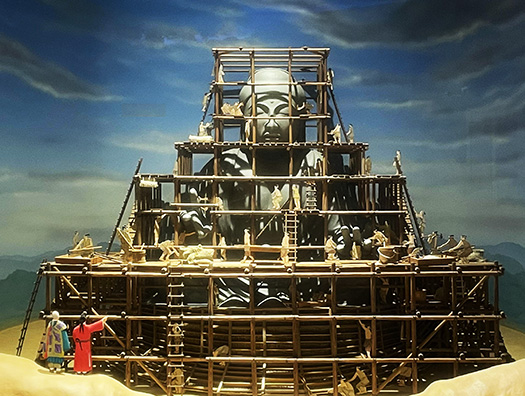

飛鳥の時代のひとつの終焉のカタチは
東大寺大仏の開眼、造立ということだったように思う。
日本という国家、その共同幻想の基軸となった大きな柱は
鎮護国家思想であり、国内諸国に国分寺を建立し
奈良にはその中枢として東大寺を建立することでその思想の完成とした。
さらにその国家大方針の中核が大仏だったのでしょう。
後の世で鎌倉にも大仏が作られたのは、律令国家とは別思想の
武家政権としての中心軸と考え、先例に倣ったのだと思える。
この奈良大仏の造立・鍍金事業は草創期国家にとって想像を絶する大事業。
752年に造立されたもので当時の鋳金工芸の粋を集めたわが国最大の鋳仏であり、
世界でも類例をみない。そして現代の工業技術への多くの啓示が秘められている。
多湿な風土をもつわが国で戦火に2度も見舞われながら腐食現象が起きていない。
これは建立当時の先人の技術“焼付け金メッキ”が行なわれたからといわれる。
大仏を造ったのは百済亡命者・国骨富の孫、国中真麻呂大仏師。
そして大鋳師・高市真国、高市真麻呂の家来の技術者など延べ42万3,000余人、
役夫218万人を使って大仏本体鋳造3年、組立てに2年、仕上げと塗金に6年、
計11年の歳月を費してやっと完成している。
高さ16m余、幅約12m、重さ112.5tという巨大さで蓮華座に坐っている。
752年(天平勝宝4)4月9日に大仏開眼会が挙行されて完成を祝ったが
鍍金メッキ作業はその後から5年掛けて行われたとされる。
「塗練金4,187両1分4銖、為滅金25,134両2分銖、右具奉。
金4,187両を水銀に溶かしアマルガムとしたもの25,224両を仏体に塗った。
金と水銀を1:5の比率で混合しアマルガムとした。
アマルガムによる金メッキが始まってから塗金仕事をする人々に病気が流行した。
この不思議な病気の原因はまさに「水銀中毒」。
蒸発する水銀を吸うことでの中毒と真相をつきとめた大仏師・国中公麻呂は、
東大寺の良弁僧上とともに毒ガスマスクを工夫して病気発生を予防した。
科学技術の進歩は公害が付きもので、これを克服しなければ進歩はない。
<東京都鍍金工業組合「奈良の大仏と表面処理」より要旨>
唐という強権国家の登場の危機的な東アジア世界情勢を受けて
必死に近代国家建設に取り組んだこの時期の歴史が生々しく立ち上ってくる。
奈良期は疫病や地震などの災害が多発したと言われる。
この大仏鍍金での公害発生などは極めつけの災禍と思われる。
悩んだ聖武帝は自ら発願した大仏造立でありながら転々と遷都を繰り返している。
しかしこういう「工業発展」の取り組みがその後の日本社会の高度化に
どれほどの貢献をしたか、計り知れないものがあると思う。
English version⬇
[Overcoming Amalgam Poisoning and Plating the Great Buddha Asuka Historical Testimony-8
The mixture of gold and mercury struck the workers as pollution. The “Jingo-no-Kokoku” of hardship. Emperor Shomu must have been deeply distressed. …
One way to end the Asuka period was the opening and construction of the Great Buddha at Todaiji Temple.
The great statue of Buddha at Todaiji Temple was the end of the Asuka period.
The major pillar that served as the basis of the common illusion of the nation of Japan was the idea of a “shin-governed state.
The main pillar of the Japanese nation, the basis of its common illusion, was the idea of a nation that would protect and defend the nation.
The idea was completed with the construction of the Todaiji Temple in Nara, which served as the center of the nation.
Furthermore, the core of this national policy was probably the Great Buddha.
The reason why the Daibutsu was also built in Kamakura in the later period was because of the idea of the central axis as a warrior government, which was a different idea from the Ritsuryo State.
The reason why the Daibutsu was also built in Kamakura in the later period seems to be that it was considered as the central axis of the samurai government and followed the precedent.
The construction and gilding of the Great Buddha in Nara was an unimaginably large undertaking for the pioneer state.
Built in 752, it is the largest cast Buddha in Japan, the culmination of the best of the metal casting craftsmanship of the time, and is unparalleled in the world.
It is also unparalleled in the world. It is also a revelation to modern industrial technology.
In Japan, which has a humid climate, the Buddha was twice exposed to war and fire, yet has not experienced any corrosion.
It is said that this is due to the excellent “baking gold plating” technique used by the predecessors when the statue was built.
The Great Buddha was built by the great Buddhist priest Kuninaka Manamaro, grandson of the Baekje exile Kokkotomi.
The Great Buddha Master Kuninaka Manamaro, grandson of the Baekje exile Kunikotsufu, built the Great Buddha, and a total of more than 423,000 people, including the great castor Koichi Makoku, Koichi Manamaro’s retainers and technicians.
It took a total of 11 years, including 3 years for casting, 2 years for assembly, 6 years for finishing and lacquering, and 2.18 million workers.
It took a total of 11 years to complete the construction.
It is 16 meters high, 12 meters wide, and weighs 112.5 tons, and sits on a lotus throne.
The completion of the statue was celebrated with an opening ceremony on April 9, 752 (Tempyo-shoho 4).
The gilding and plating work is said to have been carried out over the next five years.
The gold was plated with 4,187 gold pieces and 25,134 gold pieces.
The 25,224 kyos of gold (4,187 kyos) dissolved in mercury to form an amalgam was applied to the body of the Buddha.
Gold and mercury were mixed in a ratio of 1:5 to make an amalgam.
After the amalgam gold plating process began, there was an epidemic of illness among those who worked in the gold plating industry.
The cause of this mysterious disease was precisely “mercury poisoning.
Kuninaka Koumaro, a great Buddhist priest, discovered that the poisoning was caused by inhaling evaporating mercury.
Together with the monk Ryoben of Todaiji Temple, he devised today’s poison gas masks to prevent the outbreak of the disease.
Scientific and technological progress is accompanied by pollution, which must be overcome before progress can be made.
In response to the critical world situation in East Asia with the emergence of the powerful Tang Dynasty
The history of this period, in which people desperately worked to build a modern state, comes vividly to the fore.
The Nara period is said to have been rife with plagues, earthquakes, and other disasters.
The pollution caused by the plating of the Great Buddha is considered to be the most serious disaster.
Emperor Shomu, who was troubled by the disaster, repeatedly relocated the capital from one place to another, even though he himself had initiated the construction of the Great Buddha.
However, it is difficult to say how much this kind of “industrial development” contributed to the subsequent advancement of Japanese society.
I think it is immeasurable how much these “industrial development” efforts contributed to the subsequent advancement of Japanese society.
Posted on 6月 28th, 2022 by 三木 奎吾
Filed under: 日本社会・文化研究, 歴史探訪







コメントを投稿
「※誹謗中傷や、悪意のある書き込み、営利目的などのコメントを防ぐために、投稿された全てのコメントは一時的に保留されますのでご了承ください。」
You must be logged in to post a comment.